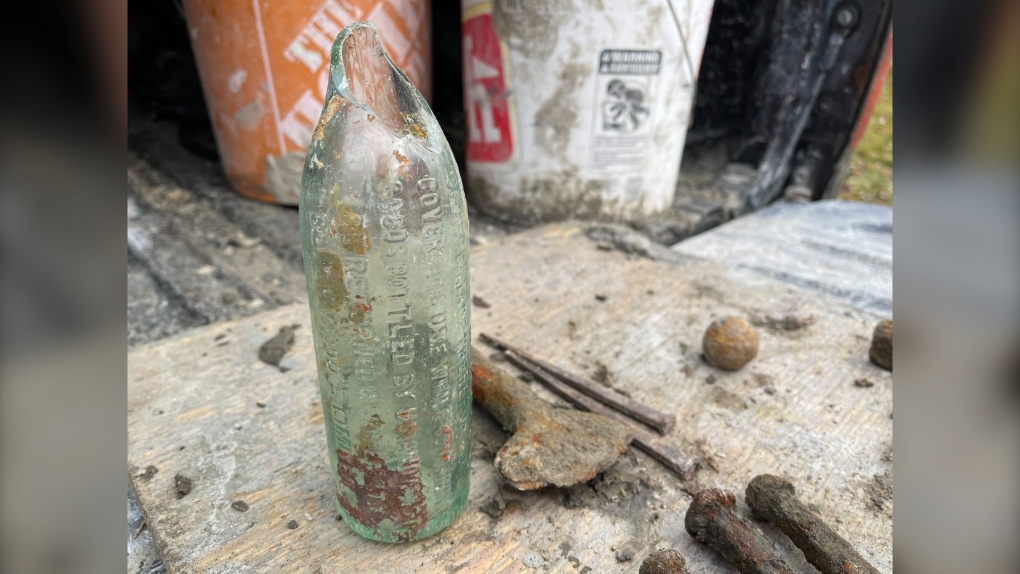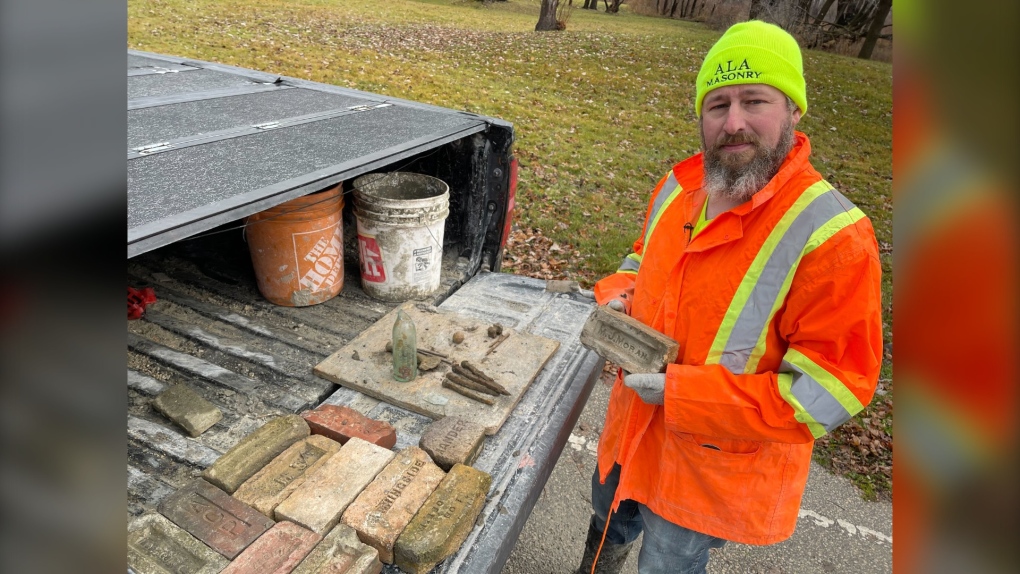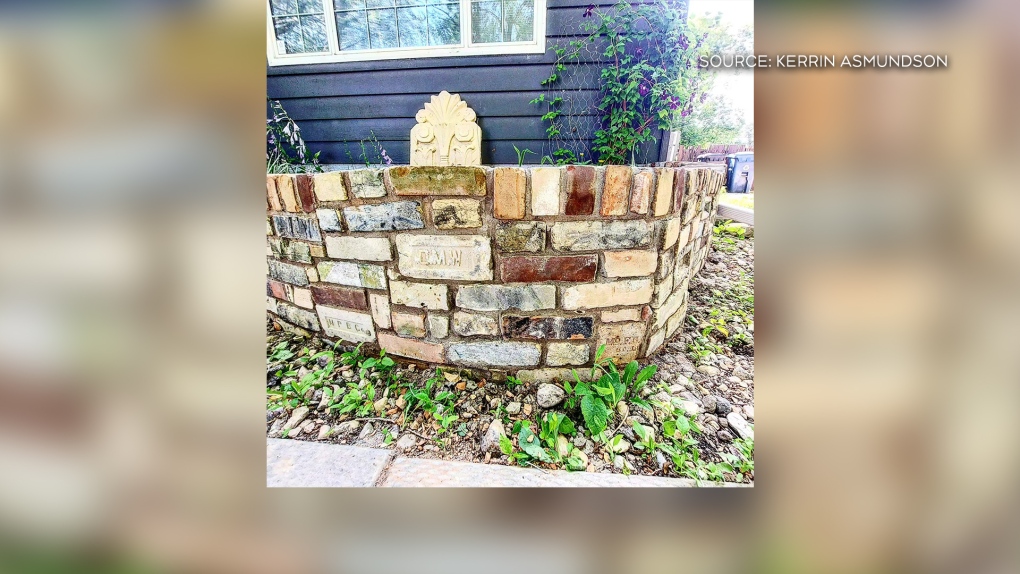Muddy riverbank finds reveal Winnipeg’s past
A recent drop in river levels is turning back the pages of time in Winnipeg and opening the doors to a hobby that is attracting people who aren’t afraid to get their feet wet and their hands dirty with an interest in Manitoba history, also known as mudlarking.
“Mudlarking is walking along the riverbank looking for historical artifacts,” said Kerrin Asmundson, a Winnipeg mudlarker who picked up the pastime this year.
In the span of a few weeks, Asmundson said he and his brother have found several pieces from Manitoba's past. Asmundson, though, is most interested in finding old bricks.
“Whenever I can add another brick to my collection, it's a good feeling,” Asmundson said, who is a mason by trade.
Among his mudlarked items are several different bricks - which he has found near old steamship docks - a bottle from an old Winnipeg brewery, as well as what Asmundson suspects are some pieces of iron from a shipwreck, and a bolt from under the Louise Bridge.
 A bottle from an old Winnipeg brewery that Kerrin Asmundson found on one of his mudlarking adventures. Uploaded Nov. 20, 2024. (Michelle Gerwing/CTV News Winnipeg)
A bottle from an old Winnipeg brewery that Kerrin Asmundson found on one of his mudlarking adventures. Uploaded Nov. 20, 2024. (Michelle Gerwing/CTV News Winnipeg)
Asmundson said he first learned about mudlarking from watching YouTube videos posted by people who do it in London along the River Thames. Some of the videos have more than a million views, and they follow along as mudlarkers find all sorts of historical artifacts and track down the piece’s story.
To get your trowel dirty along the River Thames, you need a permit from the Port of London. But good luck getting one because, according to its website, there is a 10,000-person waitlist and new applications aren’t being accepted currently. In Manitoba, a permit is not required, and all you need is the right equipment. Asmundson takes a backpack, a trowel, and a good pair of rubber boots.
“I thought, ‘Hey, we have the Red River. We have a historical city. So why not go down the river?’” he said.
The mudlarked bricks Asmundson is most interested in are the ones with identifying markings. That way he can investigate who made it and where it may have come from. He said the good ones he finds get donated to the Manitoba Brick and Block Collection at Settlers, Rails & Trails, which is a museum in Argyle, Man.
 Kerrin Asmundson standing with a myriad of items that he has found while mudlarking on Nov. 20, 2024. (Michelle Gerwing/CTV News Winnipeg)
Kerrin Asmundson standing with a myriad of items that he has found while mudlarking on Nov. 20, 2024. (Michelle Gerwing/CTV News Winnipeg)
“Finding a brick in a riverbank might not be all that exciting, but usually bricks are marked when they're manufactured, and often it's those markings that are the ones that we're looking for in the museum collection to fill the gaps that we have,” said Shayne Campbell, the president and executive director of Settlers, Rails & Trails.
Of the 750 pieces in the collection, Campbell estimates 50 to 60 of them are items that were mudlarked in Manitoba by volunteers. He explained Manitoba riverbanks are a common place for historical bricks to wash up on because there used to be 196 brick manufacturers in the province, and usually they were located along the river because water is needed in brick making.
“Riverbanks, of course, also exposed clay, which is a raw material that can be used with brick manufacturing,” he said. “So, bricks do end up along a river, whether they're thrown out on purpose or whether they're dumped there because they're extras from the industry.”
 The brick display at Settlers, Rails & Trails in Argyle, Man. Uploaded Nov. 20, 2024. (Settlers, Rails & Trails/Facebook)
The brick display at Settlers, Rails & Trails in Argyle, Man. Uploaded Nov. 20, 2024. (Settlers, Rails & Trails/Facebook)
Asmundson keeps the rest of his bricks to add to his personal collection.
“Some I have displayed in my house and some I've built into a curving wall flowerbed in front of our house that kind of tells the story of Winnipeg,” he said.
Safety is a very important part of mudlarking, Asmundson said he doesn’t get close to the water at all.
A spokesperson from the Winnipeg Fire Paramedic Service told CTV News riverbanks are constantly changing and can be affected by weather conditions and water levels.
“Residents who are spending time near the river should be cautious and mindful of the risks to themselves and first responders,” they wrote.
They remind Winnipeggers that as we approach winter, the riverbanks get slippery and that there are always hidden dangers you can’t see under the water that could lead to someone getting stuck.
 Kerrin Asmundson's flower bed that he has made out of bricks he has found along the river shore. Uploaded Nov. 20, 2024. (Kerrin Asmundson)
Kerrin Asmundson's flower bed that he has made out of bricks he has found along the river shore. Uploaded Nov. 20, 2024. (Kerrin Asmundson)
CTVNews.ca Top Stories

King Charles III focuses Christmas message on healthcare workers in year marked by royal illnesses
King Charles III used his annual Christmas message Wednesday to hail the selflessness of those who have cared for him and the Princess of Wales this year, after both were diagnosed with cancer.
Azerbaijani airliner crashes in Kazakhstan, killing 38 with 29 survivors, officials say
An Azerbaijani airliner with 67 people onboard crashed Wednesday near the Kazakhstani city of Aktau, killing 38 people and leaving 29 survivors, a Kazakh official said.
Montreal man dead after boat explodes in Fort Lauderdale
A Montreal man is dead and several others are injured after a boat exploded in Fort Lauderdale, Florida.
What is Christmas like for Quebec health-care workers who stay on the job?
Most Quebecers get together with family and friends on Christmas Eve, but many professions require people to remain on the job at all times, including health-care workers.
Second storm incoming for Christmas Day in southern B.C.
Environment Canada has issued a new series of weather warnings for British Columbia’s south coast Christmas morning.
Mother-daughter duo pursuing university dreams at the same time
For one University of Windsor student, what is typically a chance to gain independence from her parents has become a chance to spend more time with her biggest cheerleader — her mom.
Trial of man accused in Trump assassination attempt in Florida pushed back to September
A man accused of attempting to assassinate President-elect Donald Trump in South Florida won't be tried until September 2025, a federal judge ruled this week.
Pope urges 'all people of all nations' to silence arms and overcome divisions in Christmas address
Pope Francis in his traditional Christmas message on Wednesday urged 'all people of all nations' to find courage during this Holy Year 'to silence the sounds of arms and overcome divisions' plaguing the world, from the Middle East to Ukraine, Africa to Asia.
Read Trudeau's Christmas message
Prime Minister Justin Trudeau issued his Christmas message on Tuesday. Here is his message in full.
































